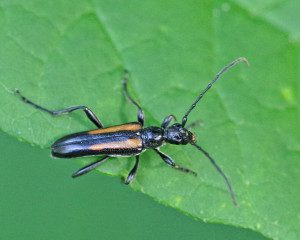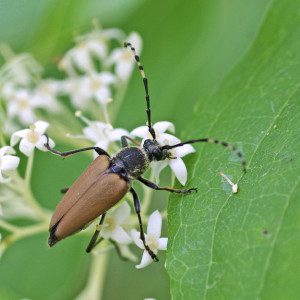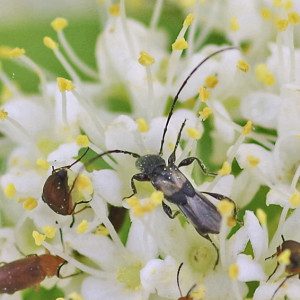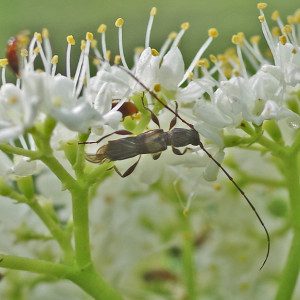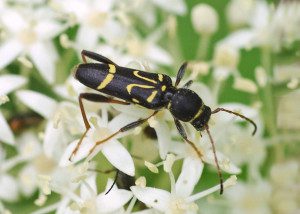Howdy, BugFans,
Back in June, the BugLady stalked the inhabitants of a dogwood that sits by the edge of a wetland. Some nice long-horned beetles – Strangaleptra abbreviate, Brachyleptura rubrica, Molorchus bimaculatus, and Clytus ruricola (no common names) enjoyed the flowers with her (as did a cast of thousands). She’s seen these beetles eating pollen on several kinds of shrubs whose flowers grow in flattened, white clusters in late spring.
Long-horned beetles (family Cerambycidae) are a charismatic bunch with a lot of devotees. Cerambycids can be remarkably long-lived – some exist as larvae for a decade and as adults for a few additional years. While their elders feed on flowers, fungi, sap, and leaves (or not at all), the larvae of many species (beetle larvae are often called grubs) bore into dead and dying trees – they’re great for decomposition, because their tunnels are doorways for water, bacteria, and fungi, but bad for timber value if they inhabit not-quite and just-dead trees. Adult cerambycids nip, some squeak (by rubbing their head against the “collar” of their thorax), many are good-sized, and some are spectacularly-patterned. And then there are those horns (antennae)! There are 1,000 or so North American species and a worldwide tally of 30,000. All four of today’s beetles reside in the eastern half of the US.
STRANGALEPTA ABBREVIATA (“shortened stripe”) is a monotypic species – alone in its genus. It’s one of the flower longhorns (subfamily Lepturinae), whose members can be dramatically wedge-shaped and who are often diurnal(active during the day). Adult Strangalepta abbreviatas can be found in the understory of both conifer and deciduous woodlands, and their larvae are generalists, found in decaying hardwoods and conifers. And that, other than its presence in biodiversity lists and photo sites, is the sum-total of what the BugLady could learn about Strangalepta abbreviata.
BRACHYLEPTURA RUBRICA (probably) (“brachy” refers to its slightly shortened elytra, or wing covers) is a flower longhorn of deciduous woods; its off-spring, which overwinter as larvae and pupate the next year, feed on decaying birch, maple, hickory, oak, cherry, and beech. In his “Beetles in the Bush” blog, Ted McRae speculates that the stage of decay is more important to it than the tree species. And that, other than its presence in biodiversity lists and photo sites, is pretty much all that the BugLady could learn about Strangalepta abbreviata.
MOLORCHUS BIMACULATUS has led the BugLady on a merry chase for several springs, now. It’s a small and active feeder, never staying in focus for very long. It looks like an ant mimic to the BugLady. Not a flower longhorn,Molorchus is in the Cerambycinae subfamily; there are only three species in the genus, and all have greatly reduced elytra, and males have antennae that are longer than their body. The larvae are found in a variety of hardwoods including maple, hackberry, and dogwood, and in grape vines.
Older books list three subspecies of Molorchus bimaculatus (“bimaculatus” means “two spots”) and say that each feeds on different plants. Bugguide.net shows pictures of three forms – the mostly blackish M. b. bimalulatus, the red-thoraxed M. b. corni, and the brownish M. b. semiustus, but says that all three can be found on the same plants at the same time, and the subspecies thing needs to be reassessed.
CLYTUS RURICOLA is a beetle that hopes that you think it’s a wasp (that’s Batesian mimicry, when something that’s harmless imitates something that’s not). The legless larvae of Clytus ruricola are found in very dead hardwoods, especially maple; adults eat pollen and like to hang out in woodland canopies.
The BugLady has mentioned before a blog called “The Backyard Arthropod Project” (“somethingscrawlinginmyhair”), by Tim Eisele, whose goal is “to document every arthropod that I can find on our property – about 9 acres on the north slope of Old Mill Hill in the Keeweenaw Peninsula of Upper Michigan.” About this beetle Eisele says “Looking at the underside, we can see why it looks like a wasp when it flies: the abdomen is banded in yellow, just like a yellowjacket or most paper wasps. It definitely has more of a beetle-like face. It also “stridulates”: when I held it, I could feel it vibrating as it moved its head up and down in a nodding motion, and if I held it next to my ear I could hear a faint “eeeeee-eeeeee-eeeeee-eeeee” noise.”
The BugLady hereby declares Longhorn Appreciation Day. Here’s some Cerambycid Eye candy: http://bugguide.net/node/view/217428/bgimage, http://bugguide.net/node/view/987104/bgimage, http://bugguide.net/node/view/230492/bgpage, http://bugguide.net/node/view/1095779/bgpage, http://bugguide.net/node/view/814705/bgpage, http://bugguide.net/node/view/734973/bgpage, http://bugguide.net/node/view/650114/bgimage.
Kate Redmond, The BugLady
The BugLady
Bug of the Week archives:
http://www4.uwm.edu/

